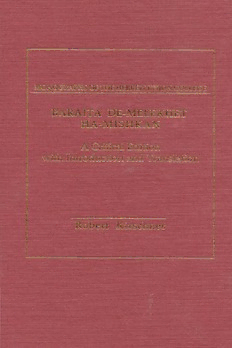Table Of ContentMonographs 01 the
Hebrew Union College
Number 15
Baraita de-Melekhet
ha-Mishkan:
A Critical Edition
with
Introduction and Translation
Monographs (כj ' th.e Hebrew Union Colfege
1. Lewis M. Barth, An Ana/ysis 01 Vatican 30
2. Samson H. Levey, The Messiah: An Aramaic lnterpretation
3. Ben Zion Wacholder, Eupo/emus: A Study 01 Judaeo-Greek
Literature
4. Richard Victor Bergren, The Prophets and the Law
5. Benny Kraut, From Relorm Judaism to Ethical Culture: The
Religious Evo/ution 01 Felix Adler
6. David B. Ruderman, The World 01 a Renaissance Jew: The Lije and
Thought 01 Abraham ben Mordecai Farisso/
7. Alan Mendelson, Secu/ar Education in Philo 01 Alexandria
8. Ben Zion Wacholder, The Dawn 01 Qumran: The Sectarian Torah
and the Teacher 01 Righteousness
9. Stephen M. Passamaneck, The Traditional Jewish Law 01 Sale:
Shul!Jan Arukh, lfoshen Mishpat, Chapters 189-240
10. Yael S. Feldman, Modernism and Cu!tural Transler: Gabrie/ Preil
and the T"adition 01 Jewish Literary Bi/ingualism
11. Raphael Jospe, Torah and Sophia: The Lzfe and Thought 01 Shem
Tov ibn Falaquera
12. Richard Kalmin, The Redaction o.fthe Babylonian Ta/mud: Amoraic
or Saboraic?
13. Shuly Rubin Schwartz, The Emergence 01 Jewish Scholarship in
America: The Publicalion o.f the Jewish Encyclopedia
14. John C. Reeves, Jewish Lore in Manichaean Cosmogony: Sludies in
lhe Book 01 Giants Traditions
15. Robert Kirschner, Baraita de-Melekhet ha-Mishkan: A Critical
Edition wilh lntroduction and Translation
Baraita de-Melekhet
ha-Mishkan
A Critical Edition
with
Introduction and Translation
Robert Kirschner
Hebrew Union College Pre.\'S
Cincinnati
@ Copyright 1992 by the Hebrew Union College Press
Hebrew Union College - Jewish וnstitute of Religion
LIBRARY OF CONGRESS CATALOGING-IN-PUBLICATION DATA
Baraita de-melekhet ha-mishkan: a critical edition with
introduction and translation / Robert Kirschner
p. cm.- (Monographs of the Hebrew Union College; no .
15 ) וncludes bibliographical references and index .
וSBN 0-87820-414-8 (hardcover: alk. paper)
1. Tabernacle-Early works to 1800. 2. Baraita de-melekhet ha -
mishkan-Criticism, Textual . ו. Kirschner, Robert (Robert S ).
ןו. Baraita de-melekhet ha-mishkan. English. 1992. I וI .
Series
BM507.5.E6E5 1992 90-27783
96.1 '263-dc20 CIP
Printed on acid-free paper
Manufactured in the United States of America
Distributed by Behrman House, Inc.
235 Watchung Avenue, West Orange, NJ 07052
Conlenl,S'
Acknowledgments VII
Abbreviations IX
INTRODUCTION
1, Description, Structure, Genre 1
2. Language, Terminology, Tradents 17
3. Parallel Passages and Medieval Citations 37
4. Origin, Date, Significance 67
5. Manuscripts and Editions 95
6. Text Criticism and Stemmatic Analysis 121
TEXT
Explanation of Transcription and Apparatus 143
Critical Symbols and Sigla 149
וכשמה תכאלמד אתיירב 151
TRANSLATION
Note on Translation and Transliteration 221
Baraita on the Construction of the Tabernacle 225
APPENDICES
A. Genizah Transcriptions 253
Plates 269
B. MS Paris Addenda 287
C. Biblical Citations in Baraita de-Melekhet ha-Mishkan 295
SELECTED BIBLIOGRAPHY 297
INDEX OF BIBLICAL AND POSTBIBLICAL SOURCES 309
GENERAL INDEX 316
Acknowledgmen.t5
A project of this kind is not possible without the assistance of many
people and insti tutions.
For permission to consult or photograph manuscripts and editions for
this study, 1 wish to thank the Jewish National University Library,
Jerusalem; Bayerische Staatsbibliothek, Munich; Bibliotheque
Nationale, Paris; Biblioteca Palatina, Parma; Bodleian Library, Oxford;
British Library, London; Cambridge University Library; Dropsie
College Library, Philadelphia; Hebrew Union College Library,
Cincinnati; and the Jewish Theological Seminary Library, New York
City. Personal thanks are owed to Benjamin Richler of the Institute for
Microfilmed Hebrew Manuscripts and Shulamith Berger and Lili
Kahan of the JTS Library for their kind cooperation.
For guidance on technical questions of paleography and codicology, 1
am indebted to Malachi Beit-Arie and the Hebrew Paleography Project.
For an introduction to statistical techniques of textual criticism, 1 wish
to thank James Joyce of San Francisco and John Dawson ofthe Literary
and Linguistic Computing Center at Cambridge University.
The arduous task of producing a technical typescript in Hebrew and
English was accomplished with singular skill and care by Ila Cherney,
Muriel Cohn, and Bonnie Gallaty. At Hebrew Union College, Michael
Meyer, Chairman of the Publications Committee, and Barbara Selya,
Assistant to the Committee, contributed invaluable advice and expertise
to the preparation ofthis book, and Richard Sarason kindly checked the
Hebrew text before the manuscript was typeset. 1 also wish to thank
Allan Satin for his work on the index.
In the course of research, 1 benefited greatly from consultation on
various aspects of this work with Jacob Sussman, the late Ephraim
Urbach, Chaim Milikowsky, Menachem Kahana, Amos Funkenstein,
Lewis Barth, Michael Signer, and Norman Cohen, who first called my
attention to Baraita de-Melekhet ha-Mishkan. To each of them 1 offer
this expression of appreciation.
A special word of thanks is owed to three scholars: Marc Bregman,
whose generous assistance and guidance were crucial to this project;
Stefan C. Reif of the Taylor-Schechter Genizah Research Unit at
Cambridge University, whose time and hospitality were graciously
v\\
Vlll 8aralta De-Melekhet Ha-Mishkan
provided; and Ben Zion Wacholder, who kindly devoted many hours
helping me to analyze the parallel passages discussed in chapter 3 of
this study_
Among my teachers a1 1he Universi1y of California a1 Berke1ey, 1
wish particu1ar1y 10 acknow1edge my debt 10 the 1a1e Baruch Bokser;
and also to Peter Brown, David Wins10n, David Daube, and Eliezer
Segal_ Above al1, 1 am gra1eful to Jacob Milgrom, whose erudition 1
can scarce1y emu1a1e and whose many kindnesses 1 canno1 hope 10
repay.
To my wife Reesa and to our children, Nili, Jesse, Talia, and Eva,
for their love and forbearance, the grea1est of all debts is owed.
Whatever the merit of this labor, it is theirs too.

